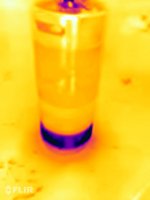- Joined
- Jan 17, 2014
- Messages
- 571
- Reaction score
- 175
Fermzilla All Rounder. A gallon remains in it and foam has filled the transfer hose. Up until that point, a combination of spunding valve and pulling keg PRV were used to keep the transfer moving.
• I tried combinations of depressurizing FV and keg. Nothing got it moving.
• Using the pressure transfer kit with the filter attachment. The filter appears to be sitting under the surface of the beer.
• 5 psi from the CO2 tank.
Assumption - the beer is over carbonated. During dry hop contact, airlock was not connected. ~20psi built into the tank. I do this to get some "free gas" for the cold crash that follows. That way, the FV doesn't implode.
Currently, the FV is sitting with the PRV open. My hope being that will allow CO2 to come out of the beer. I won't be surprised if I'm wrong.
I'd like to get that last gallon into the keg...ANY advice is welcome, thank you!
Mods please move if not in the right forum.
• I tried combinations of depressurizing FV and keg. Nothing got it moving.
• Using the pressure transfer kit with the filter attachment. The filter appears to be sitting under the surface of the beer.
• 5 psi from the CO2 tank.
Assumption - the beer is over carbonated. During dry hop contact, airlock was not connected. ~20psi built into the tank. I do this to get some "free gas" for the cold crash that follows. That way, the FV doesn't implode.
Currently, the FV is sitting with the PRV open. My hope being that will allow CO2 to come out of the beer. I won't be surprised if I'm wrong.
I'd like to get that last gallon into the keg...ANY advice is welcome, thank you!
Mods please move if not in the right forum.








![Craft A Brew - Safale S-04 Dry Yeast - Fermentis - English Ale Dry Yeast - For English and American Ales and Hard Apple Ciders - Ingredients for Home Brewing - Beer Making Supplies - [1 Pack]](https://m.media-amazon.com/images/I/41fVGNh6JfL._SL500_.jpg)




















































